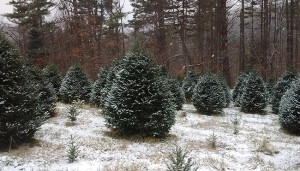It’s sales season on Christmas tree farms and, borrowing from Dave Mance’s “Dispatches from the Sugarwoods” that regularly appear in this space during the spring, here’s a look at what Christmas tree farmers are up to this time of year.
Like sugarmakers, weather forecasts are important to us, too. Too cold and it’ll be miserable outside, so people may stay home. Too warm and it won’t feel like Christmas, so people may stay home. Too much snow and it’ll be hard for customers to walk out in the field or to see exactly what each tree looks like. Too much rain and the field where customers park will turn to mud. You get the idea. The perfect forecast for selling trees at the farm, in my mind, is 28 degrees, no wind, plenty of sun, and just a sprinkling of dry snow. I don’t remember the last day we had like that.
With all of the planting, fertilizing, shearing, and mowing work done months earlier, mostly this time of year it’s just a matter of logistics on choose-and-cut farms. Placing newspaper ads, putting up signage. Do we have enough saws? Twine? Change in the change box? Room for everyone to park?
Suddenly (for us, it’s the day after Thanksgiving), the rush begins. And when they arrive, customers have plenty of questions. Over the years, I’d say that easily the most common question (after “Where’s the free hot chocolate and cookies?”) is, “How old is this tree?”
Out of curiosity I’ve taken to asking them in return, “How old do you think the tree is?” They’ll look down at the tree they just cut, size it up, and hesitantly throw out a number. “Five years old, maybe?” “It has to be at least eight, right?” Most guesses are in that range, and people are usually surprised when I tell them that the average size Christmas tree has been growing for about 12 to 15 years. The whole process started, I explain, when a nursery collected and planted a seed in a seed bed; after two or three years, it was moved to a transplant bed for another two years. So when we bought that 12-inch-tall transplant to put in our field, it was already four to five years old. It took another eight to ten years of growing and being maintained on our farm to create the tree that you’ll take home and decorate. And that process is continual, I’ll add – next spring, next to the stump you just made, we’ll plant a new tree to take its place.
This year, one customer asked if all of the trees in the field were “new.” Confused, I asked for clarification. “Did they all come this year,” he continued. I wish we could produce a nicely shaped, 8-foot Christmas tree in a single year – though I bet there would be a lot more people in the business if that were the case. I suspect that others share the notion that we growers can completely replenish our stock of trees every year, sort of like planting a new field of corn each spring, because there seems to be utter disbelief when we eventually have to put up our “sold out” sign. “But look, there are still thousands of trees out there!” many will say, pointing impatiently to all the trees left to be cut. We hate to close, I try to calmly explain. We don’t want to turn away business or disappoint kids eager to choose and cut their own tree, but over-selling would mean having to close completely in future years. Again, I try to give a quick overview of the long lag time required to grow trees, but I’m afraid that, under the circumstances, these conversations don’t immediately sink in.
Once we do have to close, there’s still a lot of clean-up work to be done before there’s a chance to pick out our own tree. Like the cobbler whose children go barefoot, Christmas tree growers often end up with a Charlie Brown tree – the one that nobody wanted – in their own homes. I usually pick a tree that’s in the way – one on the end of a row that I’ve been running into for years with the tractor, for example. It’s never a blue ribbon-winner, but once decorated, looks beautiful just the same.
If you want to go out and cut a Christmas tree this year, visit your state Christmas tree grower’s association website to find a farm near you: New Hampshire/Vermont, Maine, New York, Massachusetts, Rhode Island, Connecticut.


